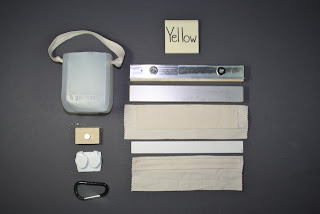What were they thinking? Not often, but more than we would like, we receive an artifact that has previously been "helped" by someone along the way. Sometimes the helping is in the form of well intentioned duck-taping to prevent a tear from further opening, sometimes it is another tape: masking or scotch, used to secure an embroidery or print to a frame or board many years ago. Or perhaps a textile has been washed and scrubbed. And other times, vacuumed (think shop-vac type). Antique flags are stitched together or cut and patched. More permanent intentions are the items that have been glued, or rubber cemented, to wooden boards or poster boards. These are the ones that make a certain conservator I know say, "oh, dear" while she shakes her head, undoubtedly feeling sorry for the poor textile or object.
 |
| Yard stick used to support an old frame. |
As the photo above illustrates, one of the interesting things about some of these creative treatments of antique, cherished, or rare items is that they are often telling of the time period they received this creative treatment. So often with framed pieces, an old newspaper is sandwiched between the object and the backing board of the frame. And sometimes flags and other textiles have also come wrapped in old newspaper, or placed in a box with the newspaper to cushion it. In the photo above a yard stick was used as a support for this old frame. These items are a great glimpse into when the object was put away as an object to be treasured.
 |
| The numerous holes in this hooked rug are held together with duct tape on both the front, as well as the back. |
Of course we know each of these "helps" were applied with the intention of doing good. And luckily none of the applications of glue, tape, or creative stitching has been impossible to undo. Tenacious in its resistance and sometimes close to almost impossible, yes, but never impossible to remove, reduce or lessen!
 |
| The back of the pastel after treatment. The tape has been removed and the damage repaired. |
I also imagine this scenario: it is sometime in the past... 25, 50, maybe even 75 years ago, and I am in possession of a rare and wonderful family treasure. Would I even have a clue that there were people working as art conservators who could help? It may not even cross my mind. But what is on my mind is: "what shall I do to keep Great Aunt Millie's girlhood sampler from falling apart?" Or the crumbling photograph of great-grandpa as a boy (see below)?
 |
| This photograph is being held together, and attached to cardboard, by various types of tape. |
In this scenario, drastic steps like glue might seem like an obvious choice. Who would have known the glue would change so much over the years, or that it would harm the fibers or paper? I imagine when they had completed their "treatment", the person doing the helping felt very proud of what they had done, and at that moment, the improvement was substantially better.
 |
| The well-worn, 206 year-old map that was hidden beneath the plastic and tape. |
So when I think about all the "oh dear's" we have seen, and how many more we will treat in the future, The answer to "What were they thinking" is quite clear: They were doing the best they could with what they had, and above all, they were trying to "help" the piece.
_____________________________
Gwen Spicer is a textile conservator in private practice. Spicer Art Conservation specializes in textile conservation, object conservation, and the conservation of works on paper. Gwen's innovative treatment and mounting of flags and textiles is unrivaled. To contact her, please visit her website.







